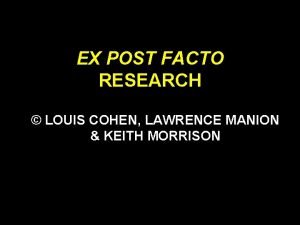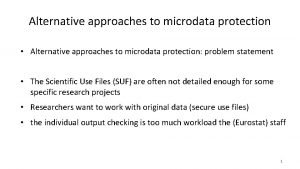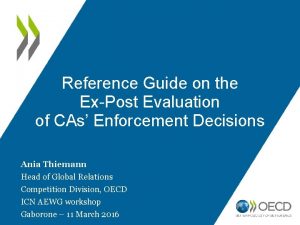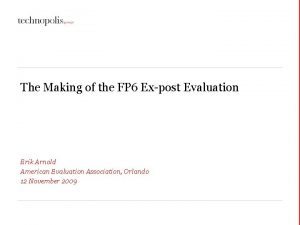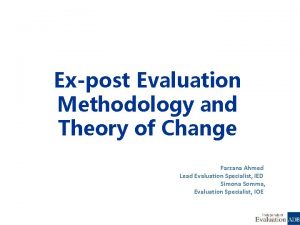Alternative approaches to the expost evaluation of individual











- Slides: 11

Alternative approaches to the ex-post evaluation of individual merger decisions Adriaan Dierx European Commission* 15 th Annual ACE Conference 2017 Universidad Carlos III de Madrid, Getafe, Spain 16 -17 November 2017 *This presentation has been prepared under the sole responsibility of its author. It does not represent the views of the European Commission 1

Outline Presentation Alternative approaches to the ex-post evaluation of individual merger decisions I. III. IV. V. Objectives of ex-post evaluation Quantitative vs. qualitative methods Descriptive & qualitative evaluations Pros and cons of different methods Conclusions 2

I. Objectives I. Objectives of ex-post evaluation of individual merger decisions 1. To increase understanding of the impact of competition policy decisions. 2. To increase transparency and accountability of competition policy decisions. 3. Advocacy of competition and competition policy. 4. Capacity building: to inform and improve future decision making practices. 3

II. Methodologies II. Alternative methodologies 1. Quantitative methodologies § Structural model simulations § Difference-in-Differences (Di. D) 2. Descriptive and quantitative methodologies § Desk research § Interviews or surveys with: • • Parties concerned Competitors Suppliers/Customers Lawyers and consultants advising the parties 4

III Descriptive & qualitative evaluations III. 1. Objective Use descriptive and qualitative methods to analyse individual merger decisions and, in particular, to test if: 1. Key assumptions about market characteristics (e. g. competitive constraints, countervailing buyer power, take-up of new technologies), which were made at the time of the decision, were well founded. 2. Ex-ante expectations about market developments (e. g. prices, entry, expansion, performance of divested entity) turned out to 5 be true.

III Descriptive & qualitative evaluations III. 2. Experience of other Competition Authorities Competition authority (year) Number of merger case decisions Methodologies used Type of decisions selected Assumptions tested Canada (2007) 3 Desk research Interviews Regression analysis Unconditional clearances Market entry Buyer market power Economic reasoning UK Deloitte study (2009) 8 Desk research Questionnaires Interviews Merger simulations 4 unconditional clearances, 3 conditional clearances and 1 prohibition Soundness of the decision Market entry New Zealand (2014 -15) 18 Desk research Interviews Cleared mergers Entry and expansion Competitors Success divestitures Buyer market power UK KPMG study (2017) 8 Desk research Interviews Unconditional and conditional clearances (5 in Phase 1 and 3 in Phase 2) Entry and expansion 6

III Descriptive & qualitative evaluations III. 3. Results Assumptions and expectations § Quite accurate, given the information available at the time of merger investigation. § Nevertheless, competition authorities did not always get it right in terms of: § Market entry and exit; § Competitive constraints from imports; § the countervailing market power of buyers. Quality of economic analysis Policy recommendations 7

III Descriptive & qualitative evaluations III. 3. Results Assumptions and expectations Quality of economic analysis § Economic reasoning sensible and no indications of significant errors of logic. § Analyses were broadly consistent and transparent. § For ex-post evaluation, it is important to collect the necessary data in time and to only consider mergers having taken place a minimum of 3 years before the review. Policy recommendations 8

III Descriptive & qualitative evaluations III. 3. Results Assumptions and expectations Quality of economic analysis Policy recommendations When taking a merger decision, the competition authority needs: § § § To clarify uncertainty regarding entry or expansion To properly gauge the assessments provided by potential entrants as they might be overly optimistic about likely success. To consider the possibility of market exit To carefully asses the competitive constraint of imports and the importance of countervailing buyer power. To assess regulatory or policy restrictions on a case-by-case basis 9

IV. Pros and cons Quantitative methods (Di. D, structural models) Descriptive and qualitative methods (Desk research, surveys and interviews) + + + - Important data requirements and risk of biased results Not easy to generalise results Provide only limited guidance on how to improve enforcement - Allow identifying a causal relationship + Provide reliable and robust estimates of the impact - Allow analysing non-price effects Allow testing of key assumptions and expectations about market characteristics and developments + Allow to improve future decision making Only provide an indication of the direction of the impact Surveys and interviews are resource intensive and subjective by nature Not necessarily easy to implement 10

V. Conclusions V. Conclusions § The two methodological complementary approaches are § A combination of a quantitative analysis with a descriptive/qualitative analysis would be optimal but challenging § Need to define the scope of ex-post evaluation exercise in light of the needs and resources of competition authority concerned. 11

